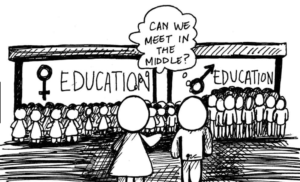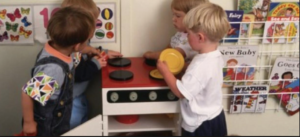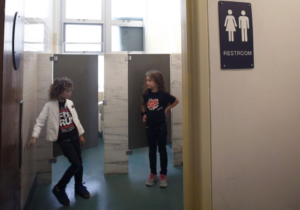
In order to investigate how pervasive gender and gender norms are in society, there is a need to look at the ways in which gender is taught outside of the home. In school, not only is curriculum material a part of the learning experience but the “correct” ways to interact with one’s peers, and the ways to govern oneself, are also taught . Teachers, whether purposefully or not, teach children the same gender expectations that the rest of society instills in them. In a particularly relevant fictional story, a child is given to a couple who were interviewed by scientists to raise a ‘genderless’ child who would go by the name and gender identity “X.” This story, titled “X: A Fabulous Child’s Story,” by Lois Gould is a great way to introduce not only the idea of what it would mean to raise a genderless child but the sheer quantity of a child’s life that is informed by the gender norms they were born into. It’s intriguing to fantasize about a world where children are raised genderless, and schools in Sweden are working towards making that a reality. We explore the same possibility in American schools, but we find that this transition is facing much resistance through research and personal reflection. By looking back on our own experiences growing up in American school systems, we are able to examine how gender norms within school environments influenced the creation of our own gender identity and our perception of others.
The Story of “X”

In “X: A Fabulous Child’s Story” the main child in the story is classified as the gender “X” in order to conduct a social scientific experiment on the centrality of gender conformity in a child’s life both in school and at home. In the story, the parents of the child are given a very large manual to help them navigate a gendered world with a genderless child. Within this manual there are rules to help the parents when choosing everything from toys and clothes to the types of sports and activities they are involved in. The parents try to make sure X is exposed to all types of activities instead of only those associated with one gender. The biggest issues arises when X starts school. It is mainly the children who are the most curious and try their best to ‘get to the bottom’ of which sex X is. The children start asking questions about X’s favorite toy and X says that it’s favorite toy is a doll (the pronoun referring to X is ‘it’), “[b]ut then X said that the doll was really a robot, and that X had computerized it, and that it was programmed to bake fudge brownies and then clean up the kitchen. After X told them that, the Other Children gave up guessing what X was” (pg. 4). Ultimately, the other children in the school not only accept X but begin to adopt some of X’s gender neutral and gender fluid tendencies. Football players begin playing with dolls and many of the children begin wearing overalls, an article of clothing meant for both genders. In the beginning, X’s identity confused those around it , but in the end, the genderless approach the parents take towards the child actually helps better inform the greater community in a way that breaks down some of the day to day gender barriers society places on children. While the story of X is a fictional one, creating spaces where children do not feel they have to conform to the gender binary is a real ambition of one Swedish school, Egalia.
Swedish Schools

One of the schools leading the way in gender neutral teaching is Egalia in Stockholm. The teachers and faculty in the school use the gender neutral pronoun “hen” to refer to the children or call them “friends”, while the children are allowed to use whatever language they like to refer to each other. Egalia has traditionally gendered toys such as dolls and toy trucks but they are strategically placed around the classroom to be inviting for all children to play with. Boys and girls are both encouraged to play dress up, be it as princesses or firefighters, without having their motives questioned.  The school stays away from books like the traditional fairy tale narrative Cinderella because of its heavy use of gender normative tropes.Instead, they strategically include books, and other classroom materials, that place an emphasis on inclusion and have a diverse range of characters – including those that are LGBT and from multiple racial backgrounds. The teachers are instructed to stay away from
The school stays away from books like the traditional fairy tale narrative Cinderella because of its heavy use of gender normative tropes.Instead, they strategically include books, and other classroom materials, that place an emphasis on inclusion and have a diverse range of characters – including those that are LGBT and from multiple racial backgrounds. The teachers are instructed to stay away from
compliments that reinforce traditional gender narratives such as telling girls that they are “pretty” and boys that they are “strong.”
There is evidence that this curriculum change is working to create a world where gender binaries do not hold as much weight. A researcher in Sweden compares the children in Egalia to other schools in the same area that take a more  traditional approach to gender and found that, “children in the gender-neutral
traditional approach to gender and found that, “children in the gender-neutral
preschool were more open to playing with children of the opposite sex [, and] they were less likely to notice another person’s gender than the children in the ordinary preschools.” As these children grow up this effect of a lack of distinction between genders may work to create a more equal playing field for everyone.
Even though these are very progressive concepts, it may not be as easy to implement this same idea in other countries. Sweden is considered one of the main leaders in gender equality worldwide, meaning that their society may be more ready for for this type of education, and they even implemented a policy into their curriculum in 1998 that says that all schools must work to eliminate gender stereotyping. They are also a fairly homogenous country, racially and culturally, so there are not different cultural norms surrounding gender to contend with.
While researching similar programs to Egalia in the U.S we found that there are some schools that are attempting to create more room for non-binary students, mainly by the creation of gender neutral bathrooms  and gender neutral uniforms in private schools, but we did not find a school that went to the same lengths to create an education experience free from gender stereotypes. The articles that we did find that seemed to be the most progressive at first, turned out to be conservative sites warning people against the danger of not adhering to “biological gender”. This political divide in America may be another reason while policies surrounding gender neutral education in the United States may not be as easy to implement as they are in Sweden.
and gender neutral uniforms in private schools, but we did not find a school that went to the same lengths to create an education experience free from gender stereotypes. The articles that we did find that seemed to be the most progressive at first, turned out to be conservative sites warning people against the danger of not adhering to “biological gender”. This political divide in America may be another reason while policies surrounding gender neutral education in the United States may not be as easy to implement as they are in Sweden.
Our Experiences:
While conversing about the possibility of American schools embracing a gender neutral educational infrastructure, we found ourselves in deep conversation rooted in memories of our own school experiences surrounding gender. As Gender, Sexuality, and Women’s Studies college students, we tend to feel more comfortable engaging with a subject using research or relating it to other theoretical works. But since we are experts on our own lives, reflection of our own childhood development in the context of our current academic studies of gender is necessary in order to track gender norms through the creation of one’s self.
We began our unfiltered and unstructured dialogue by commenting on the ways in which we understood gender as children and especially how our school experiences influenced our ideas and socialization along gendered lines. Bre, who identifies as a pansexual woman, remarked that although her elementary school didn’t enforce gender segregation beyond gendered bathrooms, she still felt a social separation from the boys during recess. She recounted that her “boyfriend” during this time happened to be one of her only close male friends, amidst her many girlfriends that she actually played with much more often. Bre pondered that she may have thought of this friend as a so-called “boyfriend” ,rather than any of her other female friends as “girlfriends”, because of larger gender norms. Perhaps this mystification of the opposite gender (whether institutionalized or not) leads children to connect success or excitement with the interactions they have with those of the opposite gender.
Bre, who identifies as a pansexual woman, remarked that although her elementary school didn’t enforce gender segregation beyond gendered bathrooms, she still felt a social separation from the boys during recess. She recounted that her “boyfriend” during this time happened to be one of her only close male friends, amidst her many girlfriends that she actually played with much more often. Bre pondered that she may have thought of this friend as a so-called “boyfriend” ,rather than any of her other female friends as “girlfriends”, because of larger gender norms. Perhaps this mystification of the opposite gender (whether institutionalized or not) leads children to connect success or excitement with the interactions they have with those of the opposite gender.
 Hannah, who also identifies as a woman, began thinking back on her own elementary school days. Hannah remembers that she used to “play mom” frequently with her close female friend, which entailed pretending to drop her kids off at school. She noted that she probably starting playing this game because she believed it would become her role one day as a woman and mother. When it came to interacting with a close male friend however, Hannah would often act out Lord of the Rings scenes with him in order to prove her knowledge of “cool guy stuff.” Hannah remarked that she didn’t enjoy this game too much, but felt the need to change her style of play for this male friend—in order to fit in with what she perceived as a boy activity. This account of recess play made us further question the idea of fitting in along gender binaries.
Hannah, who also identifies as a woman, began thinking back on her own elementary school days. Hannah remembers that she used to “play mom” frequently with her close female friend, which entailed pretending to drop her kids off at school. She noted that she probably starting playing this game because she believed it would become her role one day as a woman and mother. When it came to interacting with a close male friend however, Hannah would often act out Lord of the Rings scenes with him in order to prove her knowledge of “cool guy stuff.” Hannah remarked that she didn’t enjoy this game too much, but felt the need to change her style of play for this male friend—in order to fit in with what she perceived as a boy activity. This account of recess play made us further question the idea of fitting in along gender binaries.
 Hailey, who also identifies as a woman, remembered her elementary school experience as being very dependent on gender. Her Catholic school was much more structured around boys and girls being divided—with boys lining up separately from girls and dress codes and uniforms reflecting gender norms. Hailey recounted rejecting the idea of being too “girly” and attempting to act tough in order to appear more masculine and gain respect of her boy peers. We reflected on this common theme—that we all have observed throughout childhood and into young adulthood—of girls educating themselves with “boy activities” in order to seem cool, but the lack of boys doing the same with “girl activities”. We wonder what it would have been like to have grown up within a school like Egalia that works to dismantle the common conceptions of “boy things” as intrinsically more important than “girl things” and gender as a dividing and exclusionary factor within children’s development and socialization.
Hailey, who also identifies as a woman, remembered her elementary school experience as being very dependent on gender. Her Catholic school was much more structured around boys and girls being divided—with boys lining up separately from girls and dress codes and uniforms reflecting gender norms. Hailey recounted rejecting the idea of being too “girly” and attempting to act tough in order to appear more masculine and gain respect of her boy peers. We reflected on this common theme—that we all have observed throughout childhood and into young adulthood—of girls educating themselves with “boy activities” in order to seem cool, but the lack of boys doing the same with “girl activities”. We wonder what it would have been like to have grown up within a school like Egalia that works to dismantle the common conceptions of “boy things” as intrinsically more important than “girl things” and gender as a dividing and exclusionary factor within children’s development and socialization.
Final Thoughts:
The story of X, reflections on our own years of adolescence, and the curriculum at Egalia in Sweden show how the influence of gender can affect the childhood experience. X was a child that grew up knowing no gender, but caused it’s larger community to do many of the same things that the Egalia school in Sweden is currently doing–all of which we agree would have been beneficial to be exposed to when we were young. The influence of gender norms impacts everyone, and if we create less-gendered spaces for children, the rigid idea that the world is created around the gender binary will hopefully become less impactful on the way children explore their own identities and treat other people. We envision schools that are not gendered through institutional rules or socialization, so that trans and gender non-conforming kids might find it easier and safer to navigate their own identities without the social exclusion that has historically accompanied many in the past and today.
I read “X: A Fabulous Child’s Story” in a class I took freshman year, and I really enjoyed reading it, and have talked about it with my friends several times since then. I really loved how with the support of X’s parents, it became so possible to raise a child with the gender “X” who was happy and found supportive and loving friends. My one question is, if parents were to mimic this, how long would it take past elementary school, when this story is set, for X to develop a sense of gender because of societal influence and pressure. Or, would it be possible for child X to grow up completely without a concept of gender?